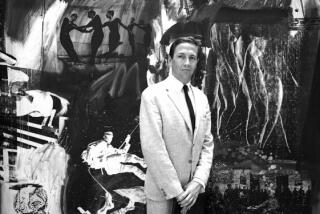Robert Frank goes from ignored to a national treasure
Looking In
Robert Frank’s “The Americans” -- Expanded Edition
Edited and with text
by Sarah Greenough
Steidl: 506 pp., $75 hardcover
He was a foreigner with a camera, a young artist newly arrived on the streets of Manhattan from the Old World, muttering over and again, “What a town, what a town . . .” Robert Frank came from Switzerland in 1947, and he was in America to stay, eager to apply his ideas about art and photography and new ways of seeing.
In a letter to his parents that first year, the photographer marveled: “Only the moment counts, nobody seems to care about what he’ll do tomorrow. . . . Whether you’ve been here for eight days or eight years, you are always treated like an American! There is only one thing you should never do, criticize anything.”
Frank found not only a home in the United States but also his greatest subject. By the end of the 1950s, he had traveled some 10,000 miles of road between the coasts and taken a hard look at the country for a book called “The Americans.” In 83 pictures of grainy black-and-white, he revealed a darkness behind the postwar euphoria, a tension and isolation amid fat American cars and bulging jukeboxes, cowboys and gray flannel suits.
“The Americans” was neither a critique nor a celebration. Frank’s natural interests lay at the margins, showing the new superpower in ashen shades of gray. His utter lack of sentimentality may have been the most shocking thing of all. This wasn’t Life magazine or Norman Rockwell. If there was something familiar about the pictures, it was that their starkness was reminiscent of the way many Americans viewed the Soviet Union, as a dark and inhuman place, marked by drudgery and low expectations.
“The Americans” was published in France in 1958, and the next year in the U.S., where it was not greeted warmly. Photography magazines hated it, and most art critics ignored it completely, as they did virtually all photography at the time. But the book was highly influential, marking a dramatic shift in the content and approach of street photography, inspiring wave after wave of visionary image-making in the work of Diane Arbus, Garry Winogrand and every generation of photographers since.
Fifty years later, Frank -- who is now 84 -- has come to be seen as a national treasure. Recently, he opened his archives to Washington, D.C.’s National Gallery of Art, which is hosting an exhibit around “The Americans.” There’s a new edition of the book (reconstructed from new scans of vintage prints) and a comprehensive program to republish all of Frank’s books and his other photography, much of it never before collected in book form. There is even a series of DVDs of Frank’s groundbreaking work as an independent filmmaker, beginning with his playful 1959 Beat Generation parable, “Pull My Daisy,” featuring Allen Ginsberg and Gregory Corso, with narration by Jack Kerouac.
At the center of all this is “Looking In: Robert Frank’s ‘The Americans,’ ” a catalog to the National Gallery of Art show. Running more than 500 pages, it is a remarkable examination of Frank’s greatest work and the two-year road trip that transformed him into a kind of photographic De Tocqueville for the nuclear age. Featuring correspondence with mentors Walker Evans and Edward Steichen, drafts of Kerouac’s original introduction and full-page reproductions of vintage contact sheets with Frank’s original markings, “Looking In” is easily the most significant, insightful study of an important photographer’s work since 2003’s “Diane Arbus Revelations.” It opens up Frank’s process of patience and instinct without diminishing the mystery or effect of the finished work.
Frank shot 767 rolls of film for “The Americans” before editing all that material down to the final images. There were pictures of stars and stripes, funerals and crucifixes, a sad-eyed young elevator operator gazing into space as a blur of passengers rushes past her. A Butte, Mont., hotel window overlooks a landscape of grime and industry. A baby crawls beneath a jukebox dropped into a South Carolina shack like the monolith in “2001: A Space Odyssey.”
The book featured brief captions -- “Trolley -- New Orleans,” “U.S. 285, New Mexico.” If any collection of photographs didn’t require words, it was “The Americans.” It hardly mattered that it was in Charleston that he photographed a white infant in the arms of a black nurse. The same scene was being repeated from Dixie to Beverly Hills to the Upper East Side.
These were not accidental compositions or chaotic snapshots but evidence, as he later put it, of a powerful “vision of hope and despair. That is what I want in my photographs.” It’s an aesthetic that is becoming as distant in this digital age as the daguerreotype, and there is no better evidence of what’s being lost in the transition than Frank’s book.
His sole authorship of a new kind of photography is often overstated. Others, such as William Klein and Louis Faurer, worked in a similar fashion that same decade, unafraid of grain and blur and visual confrontation. (Klein’s daring book of pictures, “Life Is Good and Good for You in New York,” was published in 1956, two years before “The Americans.”) Frank was part of a movement, an accelerating shift in postwar perception, but it was his book that made the most coherent statement.
What’s interesting is how his earlier work, from the 1940s and early 1950s, set a clear path as to what was coming. Even before he got the first of two Guggenheims and set out on his cross-country journey of discovery, Frank had already produced brooding images of Europe and the New World. His photographs of England (collected in “London/Wales”) were dark, elegant, foreboding, with bankers in top hats or bowlers gliding along the misty alleyways of financial London.
Although the photographer would enjoy a long association with the Beats, he wasn’t easily defined. Instead, he stood apart, a peer and not a follower, an individual on his own parallel track. In a piece unpublished until 1970, Kerouac recalled a 1958 drive to Florida with Frank: “I suddenly realized I was taking a trip with a genuine artist and that he was expressing himself in an art form that was not unlike my own and yet fraught with a thousand difficulties.”
After “The Americans,” Frank was determined not to repeat himself and searched for a means to expand on what he’d done. There would be other photography projects, including a haunting, abbreviated series of pictures shot entirely from within New York City buses. And yet the bulk of his work as a still photographer was done before 1960.
He was largely a filmmaker from that point on, with notable side trips into deeply personal mixed-media art, videotape and Polaroids. “Looking In” examines “The Americans” in the context of that later work, with several informative and thoughtful essays by, among others, Luc Sante and the book’s editor (and exhibition curator) Sarah Greenough.
For years, Frank seemed interested in pushing “The Americans” away, which only mythologized it more. Still, he couldn’t help coming back, sometimes as protector, other times as an avenging force. In some later work, he tore his early pictures into pieces and nailed them into new collages. Through it all, he has remained suspicious of fame, which Kerouac once described as being “like old newspapers blowing down Bleecker Street.”
And yet, there is his influence, which has done nothing but expand with time. The rough edges he helped introduce are everywhere now, framed by new photographers for maximum tension and effect. Their shared journey is like Frank’s picture of an empty road halfway through the last century, a strip of asphalt and mystery unspooling into the infinite horizon. “Looking In” offers us a look back, to the place where that horizon begins.
Appleford is a Los Angeles writer and photographer.
More to Read
The biggest entertainment stories
Get our big stories about Hollywood, film, television, music, arts, culture and more right in your inbox as soon as they publish.
You may occasionally receive promotional content from the Los Angeles Times.











